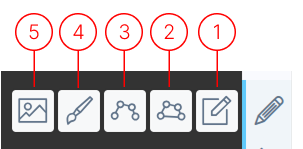Draw Annotation Tools
1. Draw Note

When editing a Note, you have two controls on the 3d view. These controls are denoted by the white dots. Click and drag either dot to make the following modifications. These controls are only available on Note creation and when editing.
-
The bottom point controls the position of the note along the surface of the asset. The point has to lie on the asset surface. It cannot be placed in mid air.
-
The top point is the leader line extension.
The following are the sidemenu options available.
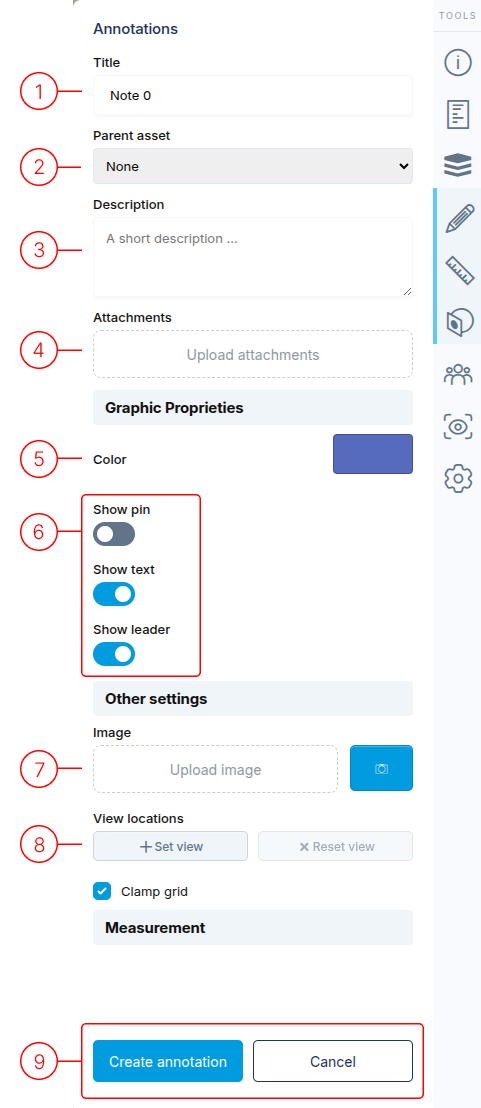
1. Title
The name of the Note annotation.
The systems automatically generates a title when a Note annotation is created.
2. Parent Asset
You can assign the Note annotation to a specific asset, or to None (which is the default)
3. Description
You can enter description information for the Note annotation.
4. Attachments
You can add attachments to the Note annotation. Most file formats are accepted.
5. Color
Select the color of the text.
Clicking on the color rectangle opens the color selection menu.
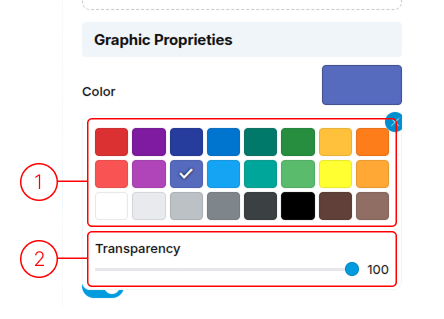
- Select from the color options.
- Adjust the opacity of the text.
6. Parts of the Note Annotation
The following toggles control the visibility of various parts of the Note annotation.
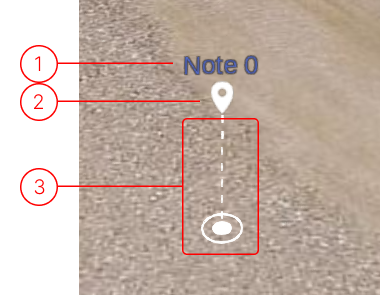
1. Text
The "Show Text" toggle the visibility of the "Text" portion of the annotation.
2. Pin
The "Show Pin" toggle controls the visibility of the "Pin" portion of the annotation.
3. Leader
The "Show leader" toggle controls the visibility of the "Leader" portion of the annotation.
7. Image upload
Each annotation can contain a features image. This image will be displayed in the @$#^@&@%$&.
8. View Location
Set the view you want for when the View annotation is clicked.
9. Save/Cancel
Select is you want to create/update the annotation or Cancel.
Cancelling will loose all changes.
2. Draw Polygon
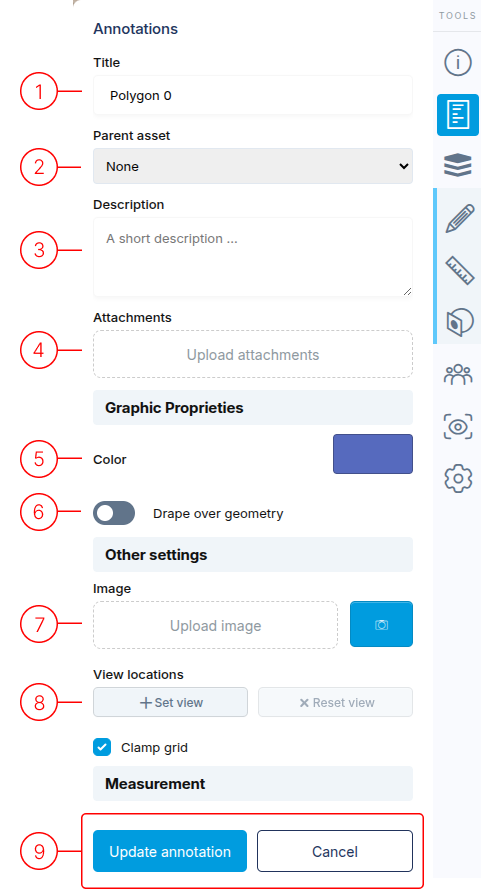
1. Title
The name of the Note annotation.
The systems automatically generates a title when a Note annotation is created.
2. Parent Asset
You can assign the Note annotation to a specific asset, or to None (which is the default)
3. Description
You can enter description information for the Note annotation.
4. Attachments
You can add attachments to the Note annotation. Most file formats are accepted.
5. Color
Select the color of the text.
Clicking on the color rectangle opens the color selection menu.

- Select from the color options.
- Adjust the opacity of the text.
6. Drape over geometry
The following toggle controls how the polygon interacts with the asset.
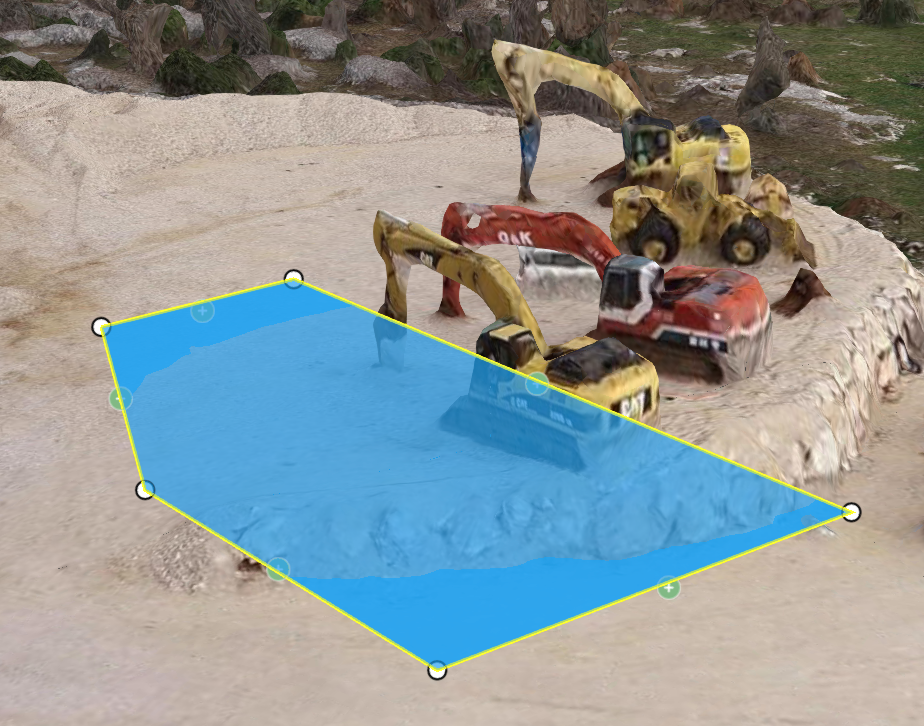 Drape over geometry is off
Drape over geometry is off
The surface of the polygon is a flat surface joining all the edges. The polygon edges are straight and directly connect the vertex points in straight lines.
 Drape over geometry is on
Drape over geometry is on
The surface of the polygon colors the asset surface. The edges follow the surface of the asset surface.
There may be undesirable side effects of using Drape over geometry if the asset has multiple surface which overlap vertically.
For example, in a house with interior floors and ceilings the polygon surface will color all floor and ceiling surfaces if Drape over geometry is turned on.
7. Image upload
Each annotation can contain a features image. This image will be displayed in the @$#^@&@%$&.
8. View Location
Set the view you want for when the View annotation is clicked.
9. Save/Cancel
Select is you want to create/update the annotation or Cancel.
Cancelling will loose all changes.
3. Draw Polyline
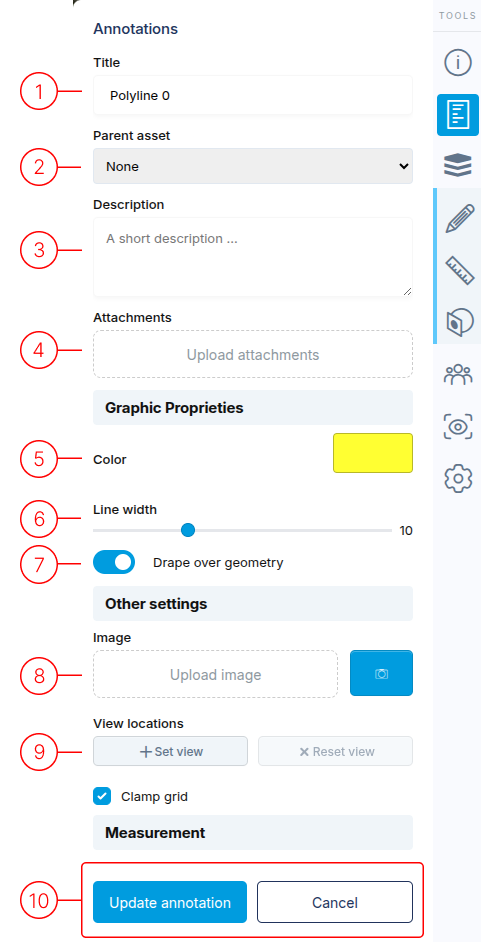
1. Title
The name of the Note annotation.
The systems automatically generates a title when a Note annotation is created.
2. Parent Asset
You can assign the Note annotation to a specific asset, or to None (which is the default)
3. Description
You can enter description information for the Note annotation.
4. Attachments
You can add attachments to the Note annotation. Most file formats are accepted.
5. Color
Select the color of the text.
Clicking on the color rectangle opens the color selection menu.

- Select from the color options.
- Adjust the opacity of the text.
6. Line Width
Controls the width of the polyline.
7. Drape over geometry
The following toggle controls how the polygon interacts with the asset.
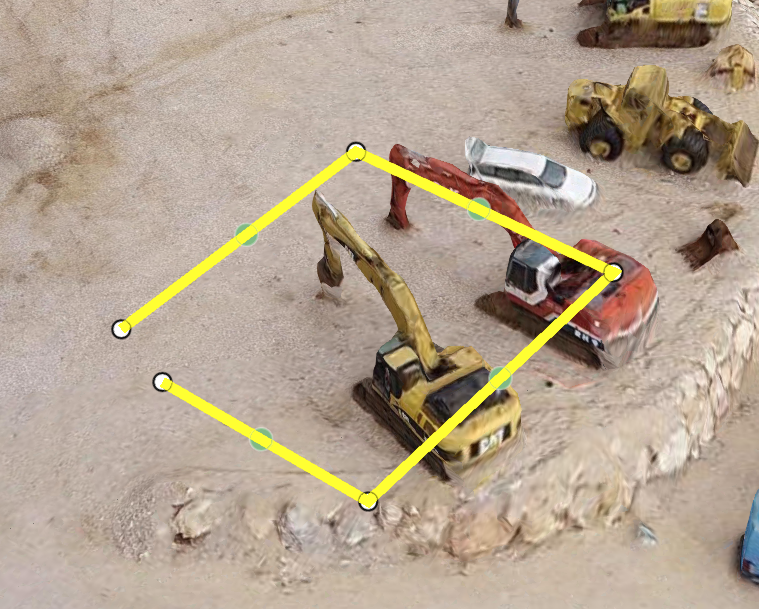 Drape over geometry is off
Drape over geometry is off
The polyline edges are straight and directly connect the vertex points in straight lines.
 Drape over geometry is on
Drape over geometry is on
The polyline edges follow the surface of the asset surface. The edges are also hidden behind asset elements.
There may be undesirable side effects of using Drape over geometry if the asset has multiple surface which overlap vertically.
For example, in a house with interior floors and ceilings the line will be visible on all floor and ceiling surfaces if Drape over geometry is turned on.
8. Image upload
Each annotation can contain a features image. This image will be displayed in the @$#^@&@%$&.
9. View Location
Set the view you want for when the View annotation is clicked.
10. Save/Cancel
Select is you want to create/update the annotation or Cancel.
Cancelling will loose all changes.
